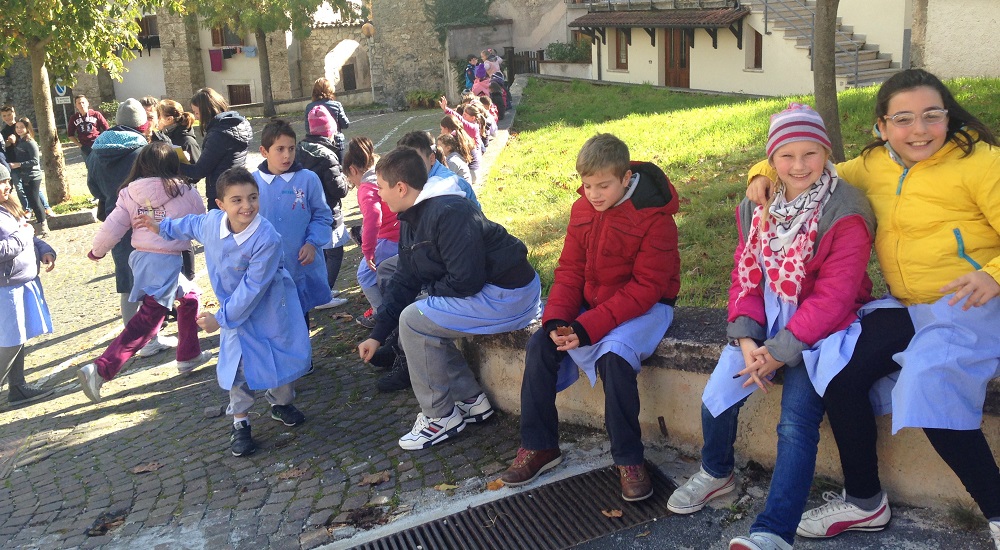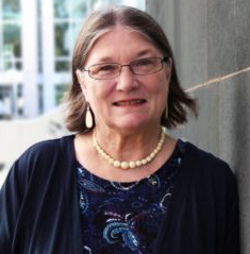
Barbara Bennett Woodhouse
During a visit to the Scanno school the earthquake alarm suddenly sounded. The children performed impeccably, first sheltering under their decks and then exiting to an open area away from the building in perfect order. Here they are clowning around to let off steam.
Stell Simonton recently talked with Barbara Bennett Woodhouse, author of “The Ecology of Childhood: How Our Changing World Threatens Children’s Rights.” Woodhouse, a national expert on children’s rights, is the L.Q.C. Lamar Professor of Law at Emory University and the director of the Emory Child Rights Project.
Her recent book examines the environments that protect children and allow them to flourish.
Stell Simonton: As you write about the ecology of childhood, you discuss a number of things at the global level that negatively impact the smaller world of childhood. Can you tell me a few of these things?
Barbara Bennett Woodhouse: I don’t mean to critique the idea of global answers to global problems. I would say globalism is something that we ought to all endorse because a lot of the issues that are problematic for children may require global solutions. So when I talk about globalization … some of what you might call the downside are mass migration, climate change, racial and religious strife, growing inequality — and technology.
Simonton: When you say technology, is there any specific example that comes to mind?

Emory University
Barbara Bennett Woodhouse
Woodhouse: The biggest threat to children’s ecology is this kind of disconnect between interpersonal relationships and their whole world. There are many ways in which technology helps children [but] I’m particularly thinking about the way in which so many young people and children basically have stronger relationships with their various wireless devices than with their peers and family.
Simonton: You write that neighborhoods and communities play a critical role in creating environments that sustain kids and families. Your book looks at two small towns, Cedar Key, Florida, and Scanno, in the Abruzzo region of Italy. You examine how the small worlds of childhood — family, school, peer group, faith community and neighborhood — are similar and different in these two towns.
Woodhouse: One really distinct difference, particularly in the beginning when I was doing my research, was exactly this issue of technology. Almost no child in Scanno had had a wireless phone. By the time I finished the study, at least the older children sometimes had them. But in the United States everybody had them. There was a difference in how much intrusion into the microsystems of a family and neighborhood and peer group was attached to these technological devices.
Another thing I noticed was that the children in Scanno tended to play with each other when they have these devices rather than playing alone. If they were sitting on a bench they’d be playing a game, passing the phone back and forth with each other.
In the town of Cedar Key there is less direct contact of people with other people. And that’s partly because of the geography. The town is kind of spread out with houses with large yards. Scanno is very close — it dates back to the Middle Ages, so you have a town where there’s a piazza and then there’s small places that children gather and families gather; everyone goes outside together. There’s times in the day when everyone goes for a walk.
[But] there’s a sense of strong community in both places. In [Cedar Key] people belong to five different churches. A lot of the social life between families and peers takes place in those different small churches.
Our children or other people’s
Going back to the pandemic, I think those two differences are playing out in the responses of the two different countries to the pandemic. For example, mask wear in Cedar Key is very rare, almost nonexistent. Whereas once everyone was called upon to wear a mask in Scanno, in Italy, generally they do.
Recently Pope Francis published an opinion piece in the New York Times. I thought that what he was getting at was this idea of solidarity, that all the people in the community are responsible for each other.
Simonton: Are you saying that a unified community is particularly important when we’re talking about the needs of children?
Woodhouse: Well, I think one of the key issues for the larger ecology of children is whether people perceive the children around them as being their own children — our children as opposed to other people’s children.
Simonton: Why is that important?
Woodhouse: Well, a good example is funding of schools and community resources for children. If you’re thinking of all the children in the community as our children, it’s easier to get money for invest[ment] in school.
I think Cedar Key, compared to many communities around the United States, is very “other-oriented.” [For example] they invested in building a community playground and the children all use it. But they’re more spread out and dispersed so it’s less likely to be a gathering place.
One of the things I talk a lot about in the book is that in a small community you can really nourish that sense of everyone caring for everyone else. It’s less likely to break down into groups who have no sense of connection to each other.
Enrich the kids or the neighborhood?
Simonton: Do you think that, as this country has become more urbanized, there has been a breakdown of groups feeling connected to each other or responsible for each other?
Woodhouse: Yes, I do. [Although] there are things that push back against that. For example, the ease of communication from one place to another makes us more connected.
But as the size of the community grows … communities have tended to segregate by income level and often by race. That sense of belonging is breaking down. That’s a problem for children because children really require everybody in this society having a sense of investment in all of the children.
Simonton: Let me ask you about two youth-serving organizations you wrote about. One, La Sanità, is in Naples, Italy, and the other, the Harlem Children’s Zone, is in New York City. They are both in urban neighborhoods that are very poor and where there was a lot of violence.
Woodhouse: [Both] were responding to the needs of the community where there’s a lot of poverty and a lot of crime, but also a sense of community identity.
What I found different between them was how they envisioned the ultimate goal …
Young people growing up in these neighborhoods were so much at risk of school leaving, and so many of them were living very much on the edge in terms of their basic needs.
The Harlem Children’s Zone grows within this whole larger cultural framework with a lot of emphasis on success — measurable success — with the schools becoming more and more clearly successful because of their grades on exams. Children were treated as separate groups. Their whole environment was to be enhanced with services to the parents, with creative teaching methods and so on.
And the ultimate goal seems to be to move up and out. To escape poverty, to escape these neighborhoods. Of course, that’s a gross generalization.
Simonton: And that’s different than the approach in La Sanità?
Woodhouse: Well, in La Sanità, the emphasis was on enriching the neighborhood and doing that by mobilizing the energy of the young people. [Although] I think some of the young people ended up leaving La Sanità or going away for periods of time to learn.
Their leader or mentor, the priest [Don Antonio] Loffredo, his inspiration was to help these kids create their own cooperatives, to learn skills and do things. So they had a number of cooperatives. One offered daycare for children in the community, and one focused on reconstructing houses and public places [including the Saint Gennaro catacombs] that were decrepit and falling apart. And so they created something that became a major tourist attraction, making it accessible to the public and leading tours through these catacombs. … They were enriching the community itself and building relationships within the community itself. It was envisioned as providing an alternative to leaving.
Simonton: Is one approach better than the other?
Woodhouse: I think that in the ideal world it would be available to every child — the opportunity to succeed even if that means leaving. … The freedom to leave is a wonderful thing.
But Loffredo wrote that his first reason for doing something in this small neighborhood in Naples was that the young people had only two choices: one was to join up with organized crime and the other was to leave.
It could reflect the difference in the cultures. So much emphasis in the United States is placed on personal liberty, maximizing one’s own potential and being free to do whatever one wants to do.
It’s a major generalization but I think in Italy there’s more of a sense of connection to one’s family, one’s home and place of birth. And that has a lot of positive impacts in terms of what we talked about earlier: Do you see all the children as members of your own community or do you see success as rising out of your community to a higher status?
Simonton: In your book you say a child-centered value system is very important to the whole of society. Can you tell me a little bit about that?
Woodhouse: It goes right along with the support of children’s rights. And for the idea of children first. I think the critique against that is, why children? Why should children receive first call on our resources as a society? Why should we be more worried about children and their well-being than we are about the rest of us?
A child-centered policy would affect how we allocate resources, where we focus our primary efforts. And I would like to see us focus more on children because I think that if you take care of the children the future takes care of itself. We like to say they’re our most precious resource but we don’t really live that.





























